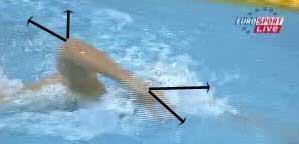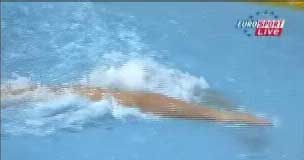Front Crawl: Mastering Hand Entry and First Pull
Hand Entry into the Water in Front Crawl
 Initial position: Just finished the recovery phase of the stroke. The arm is flexed in front of the shoulder. The elbow acts as a pivot, positioned higher than the hand. The forearm is directed forward, towards the water. The hand is slightly relaxed, flexed, and facing down and back, a few inches from the water.  Final position: The arm is slightly bent in front of the shoulder. The elbow is directed upwards and has not yet entered the water. The hand is slightly bent down and out. The thumb has made contact with the water. Description of motion: The arm is pulled through by extending the elbow. The elbow moves forward and down. The hand gradually transitions from being relaxed and facing back to having some tension, facing down and out (the entry position in the water). The thumb is the first to make contact with the water when the arm is approximately 2/5 of its total length. | Muscles Involved in Hand EntryMuscle/Fitness Home:
Muscle/Fitness School:
|

Other Considerations: If we draw two parallel lines, one from the outer side of the head and another from the inside of the shoulder, and join them with an arc, the hand should enter the water within that arc. In other words, the hand should be almost in front of the shoulder.
It is important that the entry is made with the elbow flexed and higher than the hand. If we draw a line from the elbow, it should form an angle of about 45 degrees above the water surface. The elbow should not point towards the wall but should be as high as possible.
There is some debate regarding hand entry. Applying fluid physics principles, the optimal entry angle is around 35-45 degrees to the surface and a 90-degree azimuth angle, with a slight negative angle relative to the water current. However, some coaches advocate for a flat hand entry (palm facing the water), and some world-class swimmers use this technique. The theory suggests that a flat hand entry increases resistance.
E.W. Maglischo, in “Swim Faster,” states that “hand entry with the hand prone increases resistance because the flat surface of the back of the hand pushes forward against the water. Swimmers who persist in entering in the prone position may reduce resistance if they can flex the wrist to a minimal angle. In this position, the back of the hand is not facing the immediate flow.”
As mentioned, the entry should be made with the elbow flexed and high, with the arm extended to about two-fifths of its total length. The arm should first reach its maximum length through extension and then transition to the first pull or lateral movement.
The correct way to perform this movement is to keep the elbow flexed and higher than the hand, making a gradual entry into the water. First, the edge of the hand, then the wrist, followed by the elbow, and finally the shoulder.
Remember that the arm carries inertia that should not be stopped. Entering with a fully extended arm causes a pause and wastes energy, both in stopping and restarting the movement.
First Pull: Sliding or Extension in Front Crawl
 Initial position: The arm is slightly bent and aligned with the shoulder. The elbow is directed upward and slightly outward and has not yet entered the water. The wrist is slightly bent down and out. The thumb has made contact with the water.  Final position: The arm is almost fully extended, slightly outside the shoulder line. The elbow is directed upward and outward, positioned higher than the hand. The wrist is turned down, and the hand is facing out and in the same direction.  Description of motion: The movement is primarily forward and slightly outward, achieved through the progressive extension of the arm. The elbow must always be higher than the hand and continue to be directed upward and outward. The wrist should rotate to a prone position just before full arm extension, then begin preparing for the next pull by turning out, backward, and down. The hand should face in the same direction. | Muscles Involved in Arm ExtensionMuscle/Fitness Home:
Muscle/Fitness School:
|
Other Considerations on the First Pull
Is it a pull or just a slight slip of the hand? If we define a pull as any hand movement that increases the resulting propulsive force, then the arm extension is a pull. If the hand entry is performed correctly, this movement alone, performed well, increases the resulting propulsive force.
The pressure difference due to the difference in current velocity between the palm and the back of the hand (Bernoulli’s Theorem) produces an upward force. This upward force, also called lift force, is countered by the frontal resistance force produced by the hand’s movement. The result will be positive as long as the movement is done correctly and there is a stream of water against the hand.
The resultant force vector (considering only the hand) should be perpendicular to the direction of flow. However, when considering the rest of the forces involved, there is a slight increase in propulsive force. Note: Some technical terms related to fluid dynamics have been omitted for clarity.
“Be careful to slide the hand and arm gently back into the water so that the resistance to making the gripping arm is not so large as to reduce the propulsive force generated by the arm, making the stroke,” E.W. Maglischo, “Swim Faster.”
Once the hand enters the water, it should naturally turn to a prone position. This shift should occur while stretching the arm and before finishing the extension.
This movement can be called “propulsive-slip,” as it has more positive effects than expected. For the arm to enter with minimal trauma to the environment, it must be flexed at the elbow. It would be a waste of energy to stop this movement, as elbow extension is aided by inertia and gravity.
